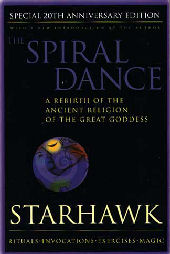| The River Reporter Thursday, October 27, 1988, p. 5 Halloween: the Celtic new year By TOM RUE Among the higher Sabbats of the ancient Europeans was Samhain, known today as Halloween or November Eve. The most sacred of the eight great festivals of European antiquity honoring Samhain, the lord of death it was (and still is, in some circles) celebrated as the combined New Year and autumn harvest festival.In the old religion which long preceded Christianity among the Anglo-Saxons, Celts, and earlier natives of England, Ireland, Gaul, and elsewhere it was the day in the earth's cycle when the walls between the worlds were thinnest and when contact with one's ancestors took place. Modern witches and Druids trace the holiday at least to the time of the builders of the henge monuments and other megalithic sites which dot the British heath, dating from sometime between the late Neolithic period and early Bronze Age. Many practitioners describe themselves as eclectic, mixing a smattering of Native American shamanism, Cabalistic traditions of the Jews, and elements of other "earth-centered" systems. Traditionalists usually attempt to shy away from mixing traditions. Adding to the significance of the Samhain festival is the fact it marks the end of the summer's harvest. The Goddess has been personified variously through the ages not only as Grain Protectress (i.e., Ceres of the Greeks); but as a beautiful and loving maiden, a fertile mother, and a wise old woman. Witches and other pagans honor the deities in all their manifestations. Worship of the archetypal Great Goddess and her male Consort crosses nearly all ancient cultures, ranging from Isis of the Egyptians, to Brigid of the Celts, to a multiplicity of Christianized versions miraculously transformed into "saints" in order to win converts to Catholicism. Paganism is a religion based on being in the world, of the world, and harming no one and yet, occasionally crossing spiritual boundaries. Powers of magick are called upon by initiates to bring about worthy purposes. For some it is difficult to heartily believe in more than that which is experienced, so we limit our values to earthly concerns like hard work, honesty, honoring the earth, accepting diversity, and enjoying life and liberty. But these matters are not lowly. Life is the consummation of existence, and death is honored as a part of life. Samhain marks the crack in time, dividing summer from winter. In pagan religions, this symbolizes the union of the Goddess and God, who share dominion over the seasons. All of existence is sacred. As the wheel of the seasons turns, witches around the world celebrate the process of life. Meeting in ritual circles, covens still gather on the night of October's full moon to honor the dead, to greet the Lord of Death who is also the Lord of Life, and to pay homage to the triple Goddess in her three aspects of maiden, Mother and Crone. Halloween is a time of retrospection, a time to look back at what has and has not been accomplished, and a time of introspection, to harmonize with the cycle of the year. Samhain rituals vary, as the practice of the religion is highly diverse. By one group, bread, wine and a candle might be placed on a small table, consecrated to providing nourishment for wandering spirits. A pomegranate or apple is sometimes used in the ceremony. The symbol of the pentacle is contained therein, when cut crosswise, and coveners are called upon to meditate on how the "seeds of death" bring new life. Speaking on behalf of the Goddess, the priestess holds up the cut fruit to the priest and declares: "Here is the circle of rebirth. Through you all passes out all of life, but through Me all may be bum again. Everything passes, changes. Seed becomes fruit; fruit becomes seed. in birth, we die.; on death, we feed. Know me, and be free of all feat. For my womb is the cauldron of rebirth; in Me, the circle is ever turning." Raymond Buckland, portage of the late Wiccan scholar Gerald Gardner, explains: "Samhain is the sacred festival marking the end of summer and the beginning of winter a time to celebrate; a time to welcome the God as he starts his journey down the tunnel of darkness that bears the light of our Lady at its end." Recommended descriptions of Wiccan festivals and beliefs may he found in The Spiral Dance by Starhawk (Harper & Row), Margo Adler's Drawing Down the Moon (Beacon Press), or Gardner's Witchcraft Today (Magickal Childe, Inc.) It was not until long after the nearly complete Romanization of Britain, in the year 43 CE, bringing the compulsory domination of the old Gods by armed force, thin Halloween (called "All Hallows Eve" or "All Saints Day" during the Dark Ages) took on its present appearance of a night when little children, disguised as demons and goblins, go house to house begging for sweets. But there are stir those in whose hearts the true fires of Samhain burn strong, who think on the memories of their ancestors and the old Gods; who love the cycles of the earth and Her children, and who worship in circles of power. Whether in solitary practice or group, ancient and modern paganism is based on spirituality and a desire to strive for the unknowable, to stare into the Light in search of essential meaning, to keep the fire ever burning.
Letter to the Editor December 22, 1988, p. 4 To Tom Rue: I want to commend you on the excellent article that was done on Halloween the Celtic New Year (Oct. 27th ). With all the Old Religion has to offer I believe you did a superb job of covering the essentials. And certainly the recommended readings were notable. Enjoy the Yule festivities. Sincerely, |
|
 LINK TO STARHAWK'S WEBSITE Related articles here. |

© 1985-2005, Tom Rue. All rights reserved.
